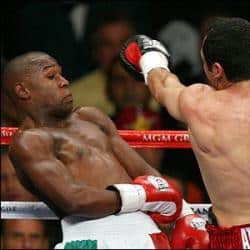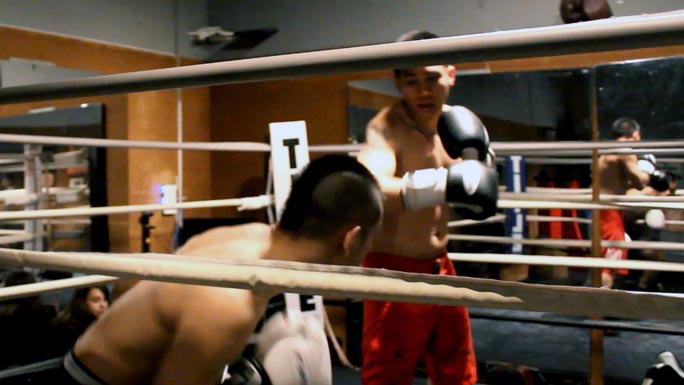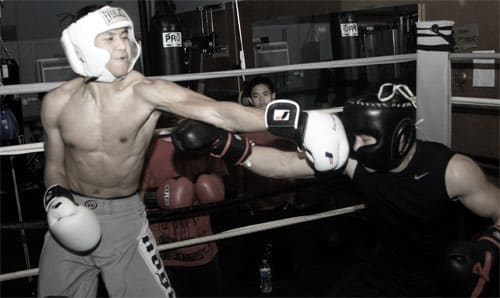
Keep moving! Stay busy! Let your punches go! Move your head!
Why should you keep moving? Some people think constant movement is a waste of energy or makes you predictable…but I completely disagree.
Constant movement is what gives you great rhythm, great endurance, great speed, and even be a trickier fighter. In an intense sport like boxing, constant movement is an important skill that you must acquire in order to be a great fighter.
But how?!
Why should you keep moving?
One of my favorite concepts to teach is to keep a fighter always moving. Even when he stops or pauses, he needs to still maintain a mindset of moving. Like “breathing” or waving his hands around or swaying slightly with his head or body. Something needs to stay in motion. Think of like when you ride the bicycle…sometimes, you want to stop and look at something but instead of stopping 100%, you simply slow down just enough but still retain a tiny bit of movement to keep the bike balanced. Same way with fighting…if you maintain a constant state of movement, it’s always easy to move. But if you keep stopping and restarting again, you lose your rhythm and more importantly, you lose your ability to think on the move, fight on the move, etc. So make sure that you stay busy in shadowboxing, bagwork, and also in the ring. You can slow down the intensity or power or speed, but never come to a sudden stop.
Benefits of constant movement:
- more endurance
- more rhythm
- more speed
- become trickier (less predictable)
- a more engaged mind
- better reflexes
The “Myths” about Constant Motion
This is an important matter to discuss. Too many people think of “constant motion” as a waste of energy or predictable movement. First off, constant movement is only a waste of energy if you don’t know how to make it benefit you AND/OR you move in an ineffective way. It’s also only a waste of energy if your main objective in the first place is never to move at all. If you don’t plan to stay busy in a fight or do anything, then yes, constant movement will seem like such a chore for you. If anything, I think constant movement takes less energy than stopping and going. Think of like maintaining a constant jogging pace VS having to start and stop again. It’s easier to pick up speed into a full sprint when you’re already in motion VS starting from 0mph off the blocks.
As for the argument that constant motion is predictable. This is a matter of how you visualize constant movement. If you think of constant movement as in doing the same things over and over, then yes, you are predictable. But you would be predictable because you keep doing the same things over, not so much because you have a rhythm. In fact…even to be unpredictable and “off-rhythm” would require that you first establish a rhythm. So in a sense, you have to have a rhythm in order to be off-rhythm. Man…was that too deep?
The RIGHT WAY to stay in motion
1. Find your natural breathing rhythm
To me, establishing your breathing rhythm, becoming aware of it, and using it as a guideline for your body’s natural rhythm is the best way to learn how to move your body. I’m sure if you’ve ever ran or skipped rope for more than half an hour, you start to become acutely aware of your natural breathing rhythm. You start to pace yourself and build a rhythm of stepping or jumping based on your breathing. Maybe it’s BREATHE-step-step-step, or BREATHE-jump-jump, etc. And of course, there’s the inhale and exhale, or the IN & OUT, or the UP & DOWN. Everybody has their own natural breathing rhythm and it’s important that you learn what that is. And then learn how to fit movements in with that breath. It will feel natural and efficient for you to move in unison with your breathing.
2. Learn how to move without committing.
When you “move”, learn how to move your core only an inch or half an inch. And then your arms and legs are free to move as much as they want. This way you can move a lot because you’re not committing so much of your body weight to each movement. This is what allows many pros to be fidgety and constantly be moving their arms around legs around and yet they don’t get tired. Because when they actually do move, it’s only a few inches, and their highly refined sense of range allows them to fight without actually moving very much. Beginners on the other hand are quite stationary and then when they do move, they move their whole entire body as much as possible which takes a colossal effort and requires tremendous amounts of energy.
3. Use the energy/feeling of movement rather than the actual movement itself
This right here is one of the hardest concepts to teach. I would say that most people look at movement simply as the change in positions of your body (or limbs) from one place to another. But for me, “movement” also has the quality of energy. There is energy in every movement. It may be low energy or high energy but there is definitely energy involved. And by energy, I don’t mean the physical intensity of the movement but the aura and presence that it has. With that being said, it’s extremely important you learn how to control the ENERGY of your movement. This is what allows you to move at times without telegraphing (or appearing to move) simply because you’re not allowing your energy to radiate externally. This ability also allows you the absolute reverse… which is to stay still physically but radiate so much energy that you do appear to move. There is much more that can be said about this but by becoming aware of this, you can really use it to move in far more deceptive ways and take advantage of your opponents reactions.
Constant movement is state of mind, body, and spirit.
What is TOO MUCH movement?
Is there such a thing? Yes… here’s where it gets confusing. I would define “too much movement” as anything that doesn’t serve a purpose and/or requires too much commitment. By serving a purpose, I mean that the movement has to do something as in attack, defend, or help you prepare for an attack or keep your defenses ready. In a sense, any movement is still purposeful even if it does nothing more than keep you in rhythm.
Moving more makes it easier for you to move more.











What’s going on with a “minimal mover” like Locche?
Amazing entry Johnny, it’s funny how constant movement is always always present in our lives and still very complex to master!
Take Care Coach!
The article is meant to present an idea and in what ways an idea can be beneficial. It isn’t to say that everyone can and should and does fight like this. In the case of Locche…he’s definitely a mover to me. Perhaps he’s more efficient and has a bit of a jerky style that emphasizes more of the sharp movements but to me he’s definitely always moving. I imagine if you got in the ring with him, you could see that he’s not as a simple as a guy just standing there and waiting for you.
great article. I am fairly new to the sport and have been so worried about movement I have over compensated and become more of a stand and deliver fighter (which has given me so issues within itself). I will try to retrain myself with your tips. This is a great site by the way. So much to learn in this sport!!! And so much seems to be a contradiction. Will I ever get there I wonder. But enjoying the journey.
Ok can someone expound on number 2 i dont really get it.
Basically move without using large body movements so less energy is expended since the limbs require less energy than the entire body. In other words, do not do exaggerated movements with you upper body constantly during the fight.
For example, depending on your fitness level, moving like Pacquiao is acceptable, but do not swing your body around like Bradley or after 6 rounds you see what happens (lol).
#2 is basically an idea that it takes you less energy to move your limbs than to move your entire body (the spine and hips). And so that you should plan your movements accordingly. In many cases, you don’t have to move your entire body so much. Moving the core only an inch while moving the limbs even more, could give you the full effect of movement while not taxing your muscles as much. And that this more efficient way of moving is easier to do when you understand range and learn how to fight within a matter of inches rather than trying to constantly bring yourself completely in and out of range.
I don’t understand
The best example of boxing like this has to be Pacquiao, he’s constantly moving in, out, up, down, left, right and he punches while he’s doing it. It looks tiring though but its obviously less tiring than getting tagged by a few hard shots from guys like Clottey or Cotto. He beat them based on sheer movement.
Hey there. I have read many articles and watch many of the videos you make and I really enjoy them and find them extremely helpful.
I am 22, 95kg and around 1.76-180cm in height (i havent measured my height for a good couple of years).
I just started boxing 3 weeks ago and have been to every practice since then. in total ive been to 9 practices and started sparring on the 2nd day and up to today have done 3 sparring sessions (they are very soft though, just sparred for 2 to 3 minutes each time)
I am not good at all i know this, im overweight, dont have good endurance but i know i can lose weight and improve my endurance.
i have problems with footwork and finding openings and keeping my eyes on the oponent and also, flinch after every punch. i believe this will improve with time and with practice right? (i have read your article for flinching and leaning back)
not looking to go pro or amateur but i really enjoy this sport.
i guess my question is should i keep sparring or wait for 1 or 2 or even 5 months to start sparring again and just practice before that? (Btw i have no experience in any martial art or ‘street fights’)
My boxing gym generally requires a beginner to have around 2+ months of technical training before they are fully assessed and deemed at least technically sound to spar. Even at that point, there are still many things to learn and improve upon. Throughout the process, they hammer into you the jab and cross and associated directional footwork, then hooks, then uppercuts. Of course, slips, parries, counter punching, and ducks are not excluded.
The fact that your boxing gym just put u in sparring on the 2nd day makes me think twice about it–one of those ones that just takes your money? But I could be wrong. Do they focus on the fundamentals? Do they stress on the footwork? Do they nag at you about your hands being where they should/shouldn’t be? Are they picky about your shoulders when you punch? When you do the pads, do they keep a watchful eye on your footwork? Are they concerned with which leg you are distributing your weight on at what time/action? Lastly, are they doing all these things without you asking? Because they should be (in my experience), and if not, then in my opinion it’s one of those gyms that take your money and throw u at the bag and in the ring.
The reason is there is no way in hell you could have even gotten the jab down by the 2nd day. No way it will even remotely resemble the jab you will have months later. And most people, even after 4 months, do not have fluid punches and footwork. Wow … day 2??? Sounds like one of those gyms…
The sooner someone begins sparring the better. They have to become comfortable in the ring and if you start early it will make jab they have months down the line so much more effective. Nobody can really hurt each other in the ring to begin with anyway, begginers are exstremely tense and they have to spend time in the ring to get rid of it. The weight of sparring gloves and natural tension means they will be finding it difficult to give the other worse than a burst nose unless there is a weight deficit… This is my opinion.
1) Practicing makes you better, keep doing it.
2) Start sparring but in a controlled manner…slow, be calm, have someone supervise you guys to prevent it from becoming a crazy fight. Any sparring is better than no sparring.
“In fact…even to be unpredictable and “off-rhythm” would already require that you first establish a rhythm. So in a sense, you have to have a rhythm in order to be off-rhythm. Man…was that too deep?”
Love it.
hey guys!
i wanted to ask you a question, everybody’s answer is welcome
i box for 4-5 month now and i have a problem about feelling sick and almost vomit when i spar.
It happens more often in the second or third round with the guys i’m not used to spar with.
I know this problem come from being too tense, I know the advice is to stay relax, try to focus on my breathing rhythym, but it’s still a major problem for me, because i can’t spar correctly.
does someone feel the same, maybe find a solution?
excuse me for my poor english
merry christmas and good training to everyone!!
Hello. The fact that it only happens against guys you are not used to and that you had already been sparring (which means you completed the medical checks), I would assume you do not have any medical conditions, and that it is due an inability to adapt to the intensity that those guys bring.
So if you don’t have a medical condition, the question is what you did or didn’t do before sparring.
Possibilities I can think of are…
1. water swirling in your stomach by the time you are at high intensity (big gulps vs small sip)
2. Improper warm-ups, leading to cramps (what warm-ups? type, intensity, duration)
3. Not enough conditioning in general and need to add 1 more session per week or change the type of session (days a week you go to training, and the intensity/type of those sessions)
These assume that you are already relaxed and that you have no medical conditions. At least I don’t see any other reason why you would feel sick if you are healthy and relaxed. Or maybe you really are tense against those guys and just need to keep sparring them (lol).
thanjs for your very complete answer, i’ll try what you said, thanks a lot!
Look into getting a fitted mouthguard. I had the same feelings as a beginner using a cheap boil and bite guard. Told some of the guys and they told me it was probably the mouthguard (I was in pretty good shape). Got a better one and never felt that way again. If you truly feel like you’re sick/about to vomit, it’s likely the mouthguard and not your fitness.
i see what you mean cause i had the same problem before and solve it by buying a best mouthguard, ans it’s much better. thanks a lot for your reply, that’s some good advice, but I think i really get too tense, because I do footing and sprint with my mouthguard on and no problem. Anyway, I’ll work on this, and thanks you again nat!
I’m completely in agreement with Kevin about the water thing. Make sure you have less than a 1/3rd cup of water in your stomach when you spar. Try to hydrate before you get to the gym and once you’re there, only take small sips of water throughout. Otherwise, you’ll get nauseous really quick from all that high intensity movement.
great article as usual, johnny….i definitely agree on your point about constantly moving, yet at the same time not over-committing. when im in the ring, if i move around too much, i find i end up compromising balance, if your opponent has good timing he can push you across the ring with a jab…
Another Great Work of Art,
Please YouTube ‘Iron Ray vs. Gonzo’. A humble painting from two of your cyber roosters.
Thank you teacher.
Gonzo
On point number 2, is this basically saying if you only move your body in inches the legs are free to move in the sense that they are free to move the body in inches many times?
I’ve seen your videos about using small steps here and my own coach made sure I did it from day one. Just wanted to make sure this is what you meant and I hadn’t misunderstood and missed something. Thanks, Dayle
Hi Dayle, check out my reply to Malik up above. It will answer your question.
hey johnny, have you ever seen jose napoles? if anybody wants to learn about constant, effortless movement, watch jose napoles…. great article!
Yeaup, great fighter!
Great article, this would probably help fighters slip punches, bob and weave, moving and grooving, because its easier to move if your already in motion, and you move faster, as opposed to stating from 0
kind of like a car, if your already at 20km/h it’ll be easier on the car and faster to get to 50 km/h as opposed to starting from 0 to 50…
Great advice Johnny. I train at Dan Birmingham’s gym and he says the exact same thing. Always move always juke never do the same thing twice. You’re usually always spot on.
Everyone do yourself a favour and learn Dancing. Ballet, Modern Jazz or even Gymnastics. It will take your footwork to another level. All great Boxer’s are great Dancers.
Apart from Napoles as mentioned above, what are other good fighters that use good constant minimal movement?
Manny Pacquiao. Marvin Hagler. Roberto Duran. Ummm….there are so many.